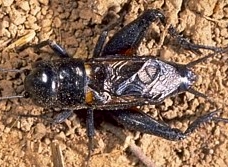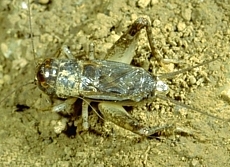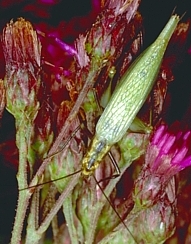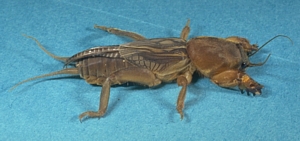|
|
ARTHROPODS:
Insects»
Spiders»
Centipedes»
Millipedes»
Sowbugs»
Harvestmen»
Mites
& Ticks»
Scorpions»
Identification
Tips»
About
the Critter Files»
Links» |
|
|
|
 |
CRICKETS
Critter
Files/Insects/Crickets
By Blake Newton
University of Kentucky Department of Entomology |
| |
|
| Common
Kentucky Crickets: |
| |
| TAXONOMY |
KINGDOM: Animalia
| PHYLUM: Arthropoda | CLASS: Insecta | ORDER: Orthoptera (grasshoppers
and crickets) |
| |
WHAT
IS A CRICKET?
LIFE CYCLE
ECOLOGY
PEST STATUS
COMMON KENTUCKY CRICKETS
COLLECTING & PHOTOGRAPHY
CRICKET FACTS
MYTHS, LEGENDS, AND FOLKLORE |
| |
| WHAT
IS A CRICKET? |
|
| Like all insects, crickets
have 6 legs, 2 antennae, and 3 body parts. Crickets are distinctive
because of their large back legs. In fact, jumping legs like
these are only found on crickets, grasshoppers,
and their relatives. Crickets and grasshoppers also have leathery
front wings (called "tegmina") which help protect the delicate
back wings. Females have a long "ovipositor" at the
tip of their abdomens which is used to lay eggs. Crickets
are very closely related to grasshoppers, and it can be difficult
to tell them apart. Although crickets are usually darker in
color than grasshoppers, there are several examples of bright green
crickets, as well as dark brown grasshoppers. In fact, grasshoppers
and crickets are so closely related that some of the insects that
we call "grasshoppers" are actually more closely related
to crickets than they are to other grasshoppers. The best
way to identify crickets is to simply become familiar with the three
different families of crickets: Gryllidae (field,
house, and tree crickets), Gryllacrididae (camel
crickets and cave crickets), and Gryllotalpidae
(mole crickets). Distinctive characters of these three families
are detailed in the common types section below.
|
|
| SIZE:
Body length of Kentucky crickets, ½" - 2" long |
| |
| LIFE
CYCLE |
|
Simple
metamorphosis: young crickets hatch from eggs and resemble small,
wingless adults. Crickets shed their skins as they grow, usually
molting several times before emerging as winged adults. Most
kinds of crickets lay eggs in the soil. Tree crickets slice
holes into plant material and deposit their eggs inside. Some
kinds of cave crickets lay eggs in bat guano. Male crickets
"chirp" to attract females. The familiar chirping
sound is produced with a "stridulating organ" located
at the base of the wings.
|
| |
| ECOLOGY |
|
Crickets
are omnivores, feeding on a variety of plant and animal materials,
including insects and their eggs. They are very common in
Kentucky, and are an important food source for a many animals, including
spiders, centipedes, birds, reptiles, amphibians, and small mammals.
Most crickets are active at night and hide during the day
under rocks and logs, except for tree crickets, which usually remain
on vegetation all day and night. |
| |
| PEST
STATUS |
|
Although
they do not infest food or harm humans, field and house crickets
are considered pests when they wander into homes, especially when
their chirping causes a disturbance. Camel and cave crickets
will commonly live in dark cellars and in crawlspaces, but they
cause no harm and prefer to stay out-of-the-way of people.
The best way to deal
with cricket pests is to keep them from entering a home. Read more
about How
to Pest-Proof Your Home.
|
| |
| |
| COMMON
KENTUCKY CRICKETS |
|
|
FIELD
CRICKETS AND HOUSE CRICKETS
FAMILY: Gryllidae
These are some of the
most commonly encountered insects in Kentucky. They are active
at night and hide during the day under rocks and logs, and occasionally
in basements, barns, and other structures. They feed on discarded
food, dead insects, and almost anything else. Field crickets
and house crickets are very similar, but field crickets tend to
be darker in color. House crickets were introduced to North
America from Europe, and are commonly raised as fish bait and pet
food. The house cricket is sometimes referred to as "cricket
on the hearth" and the "brown cricket."
|
| |
 Field
Cricket (R. Bessin, 2002)
Field
Cricket (R. Bessin, 2002) |
 House
Cricket (R. Bessin, 2000)
House
Cricket (R. Bessin, 2000) |
|
|
|
TREE
CRICKETS
FAMILY: Gryllidae
Although they are in the
same family as house and field crickets, tree crickets are often
mistaken for grasshoppers because of their bright yellow and green
colors. Tree crickets live in trees and tall plants where
they feed on leaves and small insects. Some tree cricket species
are active only at night, others are active at all times of the
day.
|
 Tree
Cricket (R. Bessin, 2000)
Tree
Cricket (R. Bessin, 2000) |
|
|
|
CAMEL
AND CAVE CRICKETS
FAMILY:Rhaphidophoridae (formerly Gryllacrididae)
These large (1 1/2"),
wingless crickets are common in dark, moist places like caves and
basements where they scavenge for decaying plant and animal materials.
Despite their fearsome appearance, they are harmless. |
| |
 Camel
Cricket (R. Bessin, 2000)
Camel
Cricket (R. Bessin, 2000)
|
|
|
|
MOLE
CRICKETS
FAMILY:Gryllotalpidae
Mole
crickets look very different than other crickets. Like real
moles, they spend their time burrowing underground and feeding on
plant roots. Some can grow to be 2" long. |
| |
 Mole
Cricket (R. Bessin, 2000)
Mole
Cricket (R. Bessin, 2000)
|
|
| |
| COLLECTING
& PHOTOGRAPHY |
|
Field and house crickets
are easy to find and collect. They are almost always present
around buildings, where they hide under boards and rocks during
the day. Similarly, camel and cave crickets are also very
common, but you may have to crawl into a basement to find them!
Tree crickets can be more of a challenge: their green color
allows them to hide in plants very well. Look for them a few
feet off the ground in trees and other plants. Mole crickets
are common, but difficult to find because they are usually underground.
They are sometimes seen flying during warm months. Although
crickets are able to move quickly, they will often remain still
for a photograph if they are not startled. |
| |
| MYTHS
- LEGENDS - FOLKLORE |
|
In some cultures, a
singing cricket in the house is considered good luck. Some people
even keep pet crickets in cages as a way to "harness"
good luck. |
| |
Original document: 25 May 2004
Last updated: 18 Aug 2008
Photos courtesy R. Bessin and B. Newton, University of Kentucky
The Kentucky Critter
Files are maintained by Blake Newton, Department of Entomology, University
of Kentucky.
Contact: blaken@uky.edu
|
|

